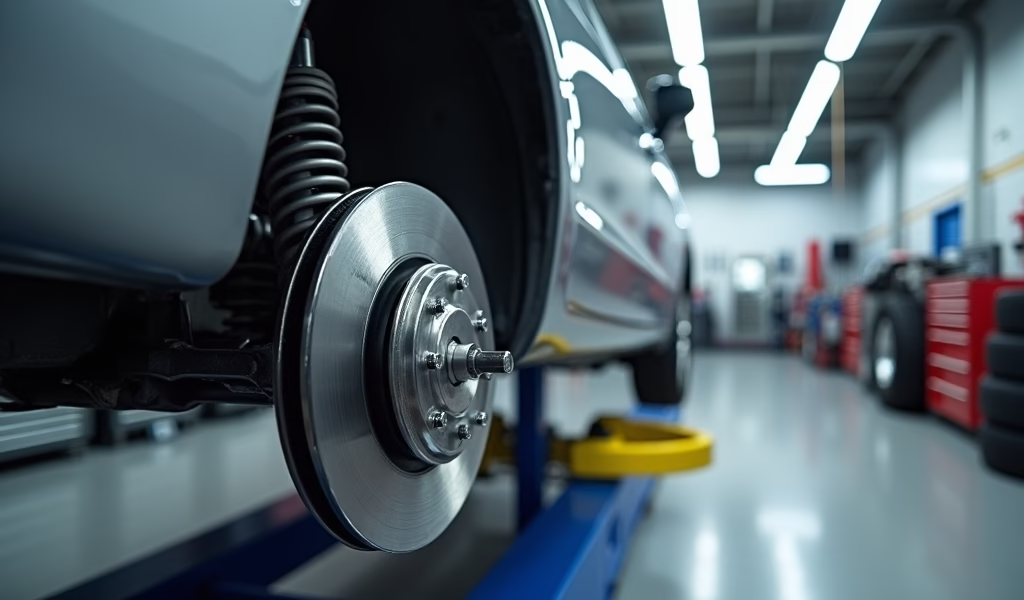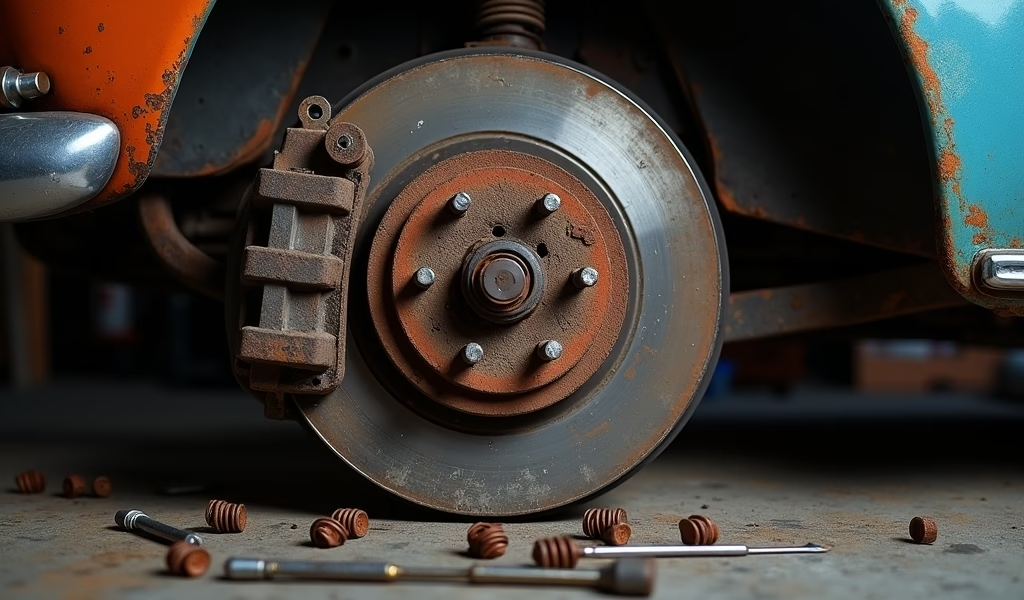Overview
This article explains drum brake self-adjustment mechanisms, which automatically maintain proper clearance between brake shoes and drums as they wear, ensuring consistent stopping power without frequent manual adjustments. It covers how these systems work, common problems like rust and debris buildup, maintenance tips including periodic “adjustment driving,” and when components should be replaced rather than simply cleaned or adjusted.
Table of Contents
- Understanding Drum Brakes: The Foundation
- Why Self-Adjustment Mechanisms Matter
- How the Drum Brake Self Adjustment Mechanism Works
- Types of Self-Adjusters: Star Wheel vs. Cable Systems
- Common Problems with Self-Adjusters
- DIY Maintenance and Adjustment Tips
- When to Replace Your Self-Adjustment Components
- Conclusion
- Frequently Asked Questions
Understanding Drum Brakes: The Foundation
The drum brake self adjustment mechanism is one of those unsung heroes in your vehicle that keeps you stopping safely without constant trips to the shop. As a mechanic with 20 years under my belt, I can tell you these little systems save drivers thousands in maintenance costs, yet most folks have no idea they exist.
Drum brakes might seem old-school compared to disc brakes, but they’re still found on many vehicles today, especially on rear wheels of economy cars and trucks. They’re simple, effective, and when working properly, require minimal maintenance. The beauty is in their design – a drum that rotates with the wheel, with brake shoes inside that press against the drum’s inner surface when you hit the brake pedal.
But there’s a catch – as those brake shoes wear down over time, the gap between the shoes and drum increases. Without adjustment, your brakes would become progressively less effective until eventually, you’d press the pedal to the floor with little stopping power. That’s where the self-adjustment mechanism comes into play.
Think of the self-adjuster as your braking system’s automatic maintenance technician, constantly making tiny adjustments to keep your stopping power consistent as your brake shoes wear down. Without this ingenious system, you’d need regular brake pedal free play adjustments at the shop.
Why Self-Adjustment Mechanisms Matter
Before self-adjusters came along in the 1950s, drivers had to manually adjust their drum brakes every few thousand miles. This meant getting under the car, removing wheels, and turning adjustment screws – not exactly weekend fun for most folks. The introduction of self-adjusters was a game-changer for automotive convenience and safety.
The primary job of the self-adjuster is maintaining the correct clearance between the brake shoes and drum. This optimal gap is critical – too wide and you’ll have excessive pedal travel with reduced braking power; too narrow and your brakes might drag, causing overheating, premature wear, and potential failure.
Beyond convenience, proper adjustment affects several aspects of your vehicle’s performance:
- Consistent brake pedal feel and travel distance
- Even braking force distribution
- Reduced risk of brake fade during extended use
- Better emergency stopping power
- Extended brake component life
According to NHTSA safety data, properly adjusted brakes can significantly reduce stopping distances in emergency situations. When every foot matters, you’ll appreciate that self-adjuster doing its job correctly.

How the Drum Brake Self Adjustment Mechanism Works
The drum brake self adjustment mechanism operates on a beautifully simple principle: using the motion that already occurs during braking to gradually adjust the position of the brake shoes. Let’s break down this process in everyday terms.
When you apply your brakes and then release them, the brake shoes move back and forth. The self-adjuster cleverly harnesses this movement. Most systems use what we mechanics call a “star wheel” or adjuster screw, which looks like a gear with star-shaped teeth (hence the nickname).
Here’s the step-by-step process of how it works:
- You press the brake pedal, and the hydraulic pressure pushes the brake shoes outward against the drum.
- As you release the pedal, the return springs pull the brake shoes back toward center.
- If the gap between the shoes and drum is too large (due to wear), the self-adjusting mechanism engages.
- An adjuster lever or pawl catches on the teeth of the star wheel and rotates it slightly.
- This small rotation expands the brake shoes outward, reducing the gap.
- The process repeats automatically whenever needed, keeping optimal clearance.
Most vehicles adjust when you apply the brakes while driving in reverse, then release them. This particular motion creates the ideal lever movement to engage the adjustment mechanism. That’s why mechanics often recommend occasional gentle stops while backing up to keep your adjusters working properly – particularly if you rarely drive in reverse.
The entire system relies on precision engineering of relatively simple mechanical parts. The adjusting lever, pawl, star wheel, and springs all work in harmony to maintain that perfect brake shoe position without any electronic sensors or computers. It’s old-school mechanical brilliance that still works perfectly in modern vehicles.
Types of Self-Adjusters: Star Wheel vs. Cable Systems
Not all drum brake self adjustment mechanisms are created equal. Over the decades, manufacturers have developed different approaches, with two main types dominating the market: star wheel adjusters and cable systems.
Star wheel adjusters (also called screw adjusters) are the most common type you’ll encounter. The star wheel resembles a gear with pointed teeth that can be rotated by the adjuster lever or pawl. Each click of the star wheel moves the brake shoes outward by a tiny, precise amount. These systems are durable, reliable, and have been refined over decades of use.
Cable systems, on the other hand, use a different approach. Instead of a star wheel, they employ a cable mechanism that automatically adjusts the brake shoe position. When the brake pedal is applied, the cable system senses excessive travel and adjusts accordingly. These systems are less common but still found in some vehicle makes.
The location and orientation of self-adjusters also vary by vehicle:
- Leading-trailing designs: Often found on rear wheels of passenger cars, with one adjuster mechanism per brake assembly
- Duo-servo designs: Common on larger vehicles and trucks, utilizing two adjuster mechanisms for more powerful braking
- Unified systems: Where the parking brake cable adjustment integrates with the service brake self-adjuster
Each design has its strengths, with manufacturers selecting the approach that best suits their vehicle’s weight, braking requirements, and cost targets. As a mechanic, I’ve worked on hundreds of different systems, and while the basic principle remains the same, the specific implementation can vary significantly between a compact car and a heavy-duty truck.
According to Brake & Front End magazine, star wheel systems remain dominant because of their simplicity, reliability, and cost-effectiveness – but all types can provide excellent service when properly maintained.
Common Problems with Self-Adjusters
Even the most cleverly designed drum brake self adjustment mechanism isn’t immune to problems. After years in the shop, I’ve seen the same issues appear repeatedly. Knowing what can go wrong helps you catch problems early before they affect your safety.
Rust and corrosion are the number one enemies of self-adjusters. These mechanisms have small moving parts that can easily seize when exposed to moisture and road salt. When rust builds up, the adjuster may stop moving freely, preventing proper adjustment. This is particularly common in vehicles driven in coastal or winter road-salt regions.
Broken springs or adjusting levers are another frequent culprit. The return springs that help position the brake shoes can weaken or break over time, and the small adjuster lever can snap if it becomes brittle with age. When these components fail, the self-adjustment feature essentially becomes disabled.
Dirt and debris buildup inside the drum can interfere with the mechanism as well. When brake dust mixes with moisture, it creates a sticky paste that can jam the star wheel or prevent the adjuster lever from properly engaging. Regular brake cleanings can prevent this issue.
Signs your self-adjuster might be failing include:
- Gradually increasing brake pedal travel (pedal goes closer to floor)
- Uneven braking when applying light pressure
- Squeaking or clicking sounds from rear wheels during braking
- Vehicle pulling to one side during gentle stops
- Parking brake requiring more clicks to engage fully
One common misconception is that self-adjusters maintain brake performance indefinitely. In reality, they can only compensate for wear up to a point. Once your brake shoes wear beyond their serviceable thickness, no amount of adjustment will restore proper braking. This is why regular inspections remain important even with self-adjusting brakes.

DIY Maintenance and Adjustment Tips
While drum brake self adjustment mechanisms are designed to work without intervention, a little preventative maintenance goes a long way in extending their lifespan. Here are some DIY tips from someone who’s had his hands inside countless brake drums.
First, occasional “adjustment driving” helps keep everything working. Once a month, find an empty parking lot or quiet road, drive in reverse for a short distance, then apply the brakes firmly (but not in a panic stop). This deliberate action helps engage the self-adjustment mechanism. Repeat 3-5 times, and you’ve just given your adjusters a little exercise.
If you’re comfortable working on your vehicle, an annual inspection can catch problems early. This requires removing the brake drum, which might need special tools depending on your vehicle model. Once inside, look for:
- Smooth operation of the star wheel when turned by hand
- Intact springs without stretching or damage
- Clean, unobstructed movement of all components
- Proper engagement of the adjusting lever
- Signs of fluid leaks from wheel cylinders
Lubrication is critical but often overlooked. The star wheel and adjuster threads should receive a very light application of high-temperature brake grease. Be extremely careful not to get any lubricant on the friction surfaces of the drums or shoes! Even a tiny amount can severely impact braking performance.
If your self-adjuster isn’t working correctly, you can perform a manual adjustment to restore proper brake pedal feel. You’ll need a specialized brake tool or flat screwdriver to turn the star wheel. The general process is:
- Safely jack up and secure the vehicle
- Remove the wheel
- Locate the adjustment hole (usually on the back of the brake backing plate)
- Insert your tool and turn the star wheel (typically moving the top of the wheel toward the front of the vehicle expands the shoes)
- Turn until you feel resistance, then back off slightly
Remember that manual adjustment is a temporary fix. If your self-adjuster isn’t working, it’s better to repair the underlying issue rather than repeatedly adjusting manually.
When to Replace Your Self-Adjustment Components
No mechanical system lasts forever, and drum brake self adjustment mechanisms are no exception. Knowing when to replace components rather than just clean or adjust them is an important skill for maintaining your braking system safely.
As a rule of thumb, any time you replace brake shoes, you should carefully inspect the entire self-adjustment system. The cost of new adjusters and springs is minimal compared to the labor involved in accessing the brake assembly, so this is the perfect opportunity for preventative replacement.
Look for these telltale signs that replacement, not just cleaning, is necessary:
- Visible wear or damage to the star wheel teeth
- Stretched, discolored, or broken springs
- Rust that doesn’t clean off easily with a wire brush
- Adjuster lever that feels loose or doesn’t engage properly
- Seized adjustment screws that won’t turn smoothly even after lubrication
Many quality brake shops offer complete drum brake hardware kits that include all the small parts for a complete renewal: springs, adjusters, levers, and pins. These kits typically cost between $15-40 per wheel and provide peace of mind that all wear components are fresh.
If you’re handling this project yourself, take photos before disassembly. The arrangement of springs and levers can be confusing during reassembly, especially for first-timers. A reference photo saves tremendous frustration. Also, replace one side at a time, using the other as a reference.
Remember that brake work affects your safety and the safety of others on the road. If you’re uncertain about any aspect of the job, professional installation is worth the cost. Most shops charge 1-2 hours of labor for drum brake service per axle, which includes inspecting and replacing the self-adjustment components.
Conclusion
Understanding the drum brake self adjustment mechanism gives you valuable insight into one of your vehicle’s most important safety systems. These clever mechanical devices have been saving drivers from constant brake adjustments for decades, quietly maintaining proper brake performance as components wear.
We’ve explored how these systems work through simple mechanical principles, the different types you might encounter, common problems to watch for, and maintenance approaches that help extend their service life. While they’re designed to work without intervention, a little knowledge and occasional attention can prevent most self-adjuster issues before they affect your braking.
Whether you’re a DIY enthusiast or someone who prefers professional service, recognizing the signs of adjuster problems helps you address them promptly. Remember that proper brake performance depends on this small but crucial system working correctly.
The next time you press your brake pedal and feel that firm, consistent response, you can appreciate the drum brake self adjustment mechanism doing its job behind the scenes. In a world of increasingly complex automotive technology, it’s refreshing to find a solution so elegantly simple and effective.
Frequently Asked Questions
How often do drum brake self-adjusters need maintenance?
Self-adjusters typically need inspection every 30,000 miles or during brake shoe replacement. They may require cleaning and lubrication if you drive in dusty or high-moisture environments.
Can I drive with a faulty self-adjuster?
It’s not recommended as brake performance will gradually deteriorate, potentially creating an unsafe condition. A faulty adjuster should be repaired as soon as possible.
Will my brake warning light come on if the self-adjuster fails?
No, most vehicles don’t have sensors monitoring the mechanical adjustment system. You’ll notice symptoms like a gradually lowering brake pedal instead.
Are aftermarket self-adjusters as good as OEM parts?
Quality varies significantly between brands. Premium aftermarket parts from established brake manufacturers often match or exceed OEM quality, while budget options may have shorter service lives.
How much does it cost to replace drum brake self-adjusters?
Parts typically cost $15-40 per wheel for a complete hardware kit. Labor at a professional shop usually runs 1-2 hours per axle at standard shop rates.

